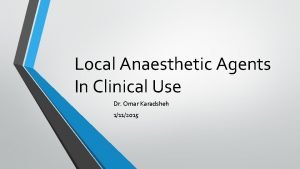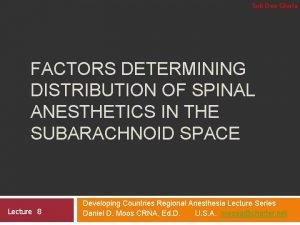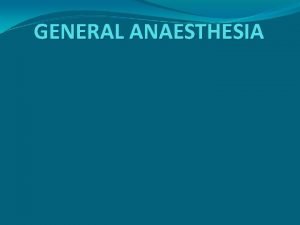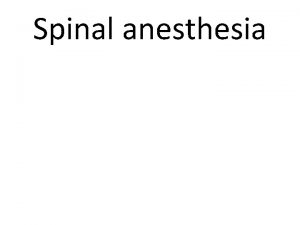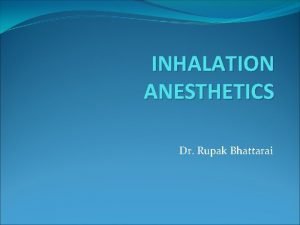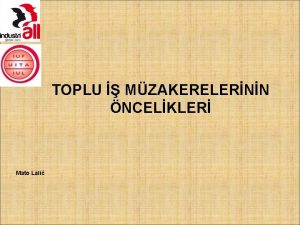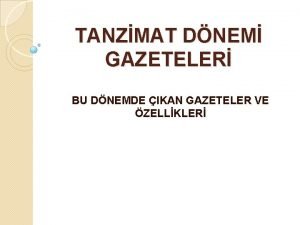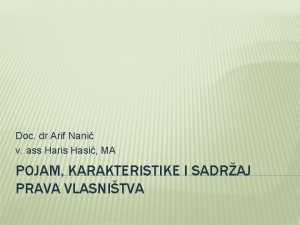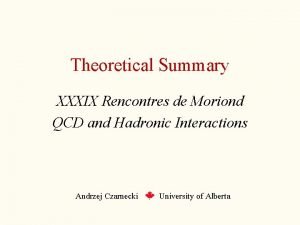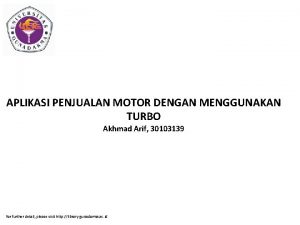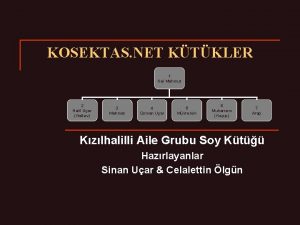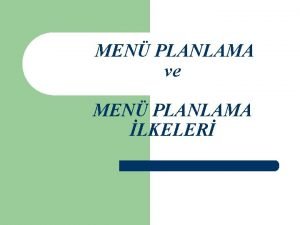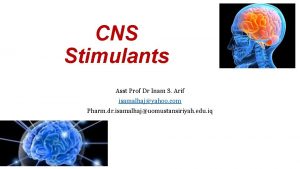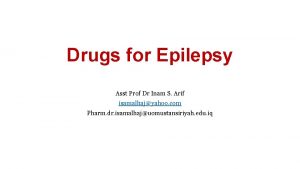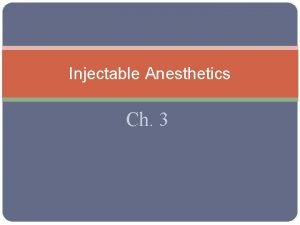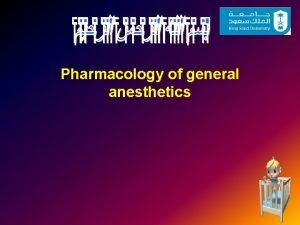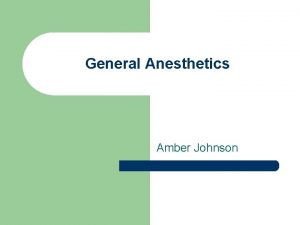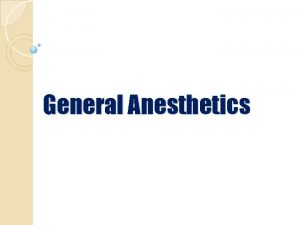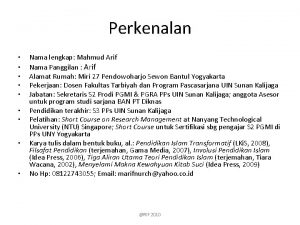Anesthetics Asst Prof Dr Inam S Arif isamalhajyahoo































- Slides: 31

Anesthetics Asst Prof Dr Inam S. Arif isamalhaj@yahoo. com Pharm. dr. isamalhaj@uomustansiriyah. edu. iq

General anesthesia is a reversible state of CNS depression, causing loss of response to and perception of stimuli. For patients undergoing surgical rocedures, anesthesia provides: • Sedation and reduced anxiety • Lack of awareness and amnesia • Skeletal muscle relaxation • Suppression of undesirable reflexes • Analgesia

Status Organ System • CVS: suppress CV function to varying degrees (hypotension may develop during anesthesia, resulting in reduced perfusion pressure and ischemic injury to tissues) • Halothane sensitizes the heart to arrhythmogenic effect of sympathomimetics • Respiratory system: • Asthma and ventilation or perfusion abnormalities complicate control of inhalation anesthetics. • Inhaled agents depress respiration but also act as bronchodilators

• Liver and kidney: • influence long-term distribution and clearance of drugs and are • Release of fluoride, bromide, and other metabolites of halogenated HC can affect these organs, especially if they accumulate with frequently repeated administration of anesthetics. • Nervous system: • Presence of neurologic disorders (epilepsy, myasthenia gravis, neuromuscular disease, compromised cerebral circulation) influences the selection of anesthetic. • Pregnancy: • Effects on fetal organogenesis in early pregnancy • Transient use of nitrous oxide may cause aplastic anemia in the fetus • Oral clefts have occurred in fetuses when mothers received BZDs in early pregnancy. • BZDs should not be used during labor because of resultant temporary hypotonia and altered thermoregulation in the newborn.

Concomitant use of drugs • Preanesthetic medications: Ø H 2 blockers (famotidine, ranitidine) to reduce gastric acidity; ØBZDs (midazolam, diazepam) to reduce anxiety and facilitate amnesia Ø Nonopioids (acetaminophen, celecoxib) or opioids (fentanyl) for analgesia ØAntihistamines (DPH) to prevent allergic reactions ØAntiemetics (ondansetron) to prevent nausea; and/or anticholinergics (glycopyrrolate) to prevent bradycardia and secretion of fluids into the respiratory tract ( ØPremedications facilitate smooth induction of anesthesia and lower required anesthetic doses Øenhance undesirable anesthetic effects (hypoventilation) • Concomitant use of other drugs: • e. g. alcoholics have elevated levels of liver enzymes that metabolize anesthetics, and drug abusers may be tolerant to opioids.

Depth of anesthesia Four sequential stages characterized by increasing CNS depression as the anesthetic accumulates in the brain Ø Stage I—Analgesia: • Loss of pain sensation results from interference with sensory transmission in the spinothalamic tract. • patient progresses from conscious and conversational to drowsy • Amnesia and reduced awareness of pain occur as stage II is approached.

ØStage II—Excitement: • The patient displays delirium and possibly combative behavior • A rise and irregularity in blood pressure and respiration occur, as well as a risk of laryngospasm • To shorten or eliminate this stage, rapid-acting IV agents are given before inhalation anesthesia is administered. ØStage III—Surgical anesthesia: • There is gradual loss of muscle tone and reflexes as the CNS is further depressed • Regular respiration and relaxation of skeletal muscles with eventual loss of spontaneous movement occur • This is the ideal stage for surgery • Careful monitoring is needed to prevent undesired progression to stage IV. ØStage IV—Medullary paralysis: • Severe depression of the respiratory and vasomotor centers occurs • Ventilation and/or circulation must be supported to prevent death.

Inhalation Anesthetics • Maintenance of anesthesia after administration of an IV agent • Depth of anesthesia / inhaled concentration • Inhalational agents have very steep DRCs and very narrow TIs • No antagonists exist • To minimize waste / recirculation system • Anesthetics are nonflammable, nonexplosive agents, including nitrous oxide and volatile, halogenated hydrocarbons. • Decrease cerebrovascular resistance, resulting in increased brain perfusion • Movement depends on their solubility in blood and tissues, as well as on blood flow

Potency • MAC: minimum alveolar conc. of vapor in the lung required to prevent movement in 50% of subjects in response to surgical stimuli • MAC is the median effective dose (ED 50) of the anesthetic • The inverse of MAC is, an index of potency Sevoflurane -----small value of MAC------ high potency Nitrous Oxide------large value of MAC-----low potency • MAC values are used to compare strength of different anesthetics • The more lipid soluble an anesthetic, the lower the concentration needed to produce anesthesia and, thus, the higher the potency • Factors that can increase MAC (make the patient less sensitive) include hyperthermia, drugs that increase CNS catecholamines, and chronic ethanol abuse • Factors that can decrease MAC (make the patient more sensitive) include increased age, hypothermia, pregnancy, sepsis, acute intoxication, concurrent IV anesthet- ics, and α 2 -adrenergic receptor agonists (for example, clonidine, dexmedetomidine).

Uptake and distribution of inhalation anesthetics • Brain partial pressure (Pbr) of inhaled anesthetic = partial pressure equilibrium between alveoli [Palv] and brain [Pbr] • The partial pressure of an anesthetic gas at the respiratory pathway is the driving • At equilibrium, Palv = Pa = Pbr. The time course for attaining this steady state is determined by the following factors: ØAlveolar wash-in ØAnesthetic uptake ØEffect of different tissue types on anesthetic uptake: ØWashout

1 - Alveolar wash-in: Refers to replacement of normal lung gases with the inspired anesthetic mixture ü The time required for this process is directly proportional to the functional residual capacity of the lung (volume of gas remaining in the lungs at the end of a normal expiration) and inversely proportional to ventilatory rate üIt is independent of the physical properties of the gas ü As the partial pressure builds within the lung, anesthetic transfer from the lung begins.

2. Anesthetic uptake (removal to peripheral tissues other than the brain) Uptake is the product of gas solubility in the blood, cardiac output (CO), and the gradient between alveolar and blood anesthetic partial pressures. a. Solubility in blood: b. Cardiac output: c. Alveolar-to-venous partial pressure gradient of anesthetic

3. Effect of different tissue types on anesthetic uptake: a. Brain, heart, liver, kidney, and endocrine glands: highly perfused Ts / rapidly attain steady state b. b. Skeletal muscles: poorly perfused during anesthesia /large volume / prolongs the time required to achieve steady state. c. Fat: poorly perfused /volatile anesthetics are very lipid soluble / fat has a large capacity to store them/ slow delivery to a high-capacity compartment prolongs the time required to achieve steady state in fat tissue. d. Bone, ligaments, and cartilage: poorly perfused /relatively low capacity to store anesthetic / minimal impact on the time course

4. Washout ØWhen an inhalation anesthetic is discontinued, the body becomes the “source” that drives the anesthetic back into the alveolar space ØThe same factors that influence attainment of steady state with an inspired anesthetic determine the time course of its clearance from the body ØThus, nitrous oxide exits the body faster than halothane

Mechanism of action • Many molecular mechanisms may • Increase GABAergic receptors activity / GABAA • Nitrous oxide and ketamine do not have actions on GABAA Rs. • NMDA: inhibition of the N-methyl-D-aspartate (NMDA) Rs • Glycine: enhance inhibitory activity of glycine receptors in the spinal motor neurons • Nicotinic Rs: block excitatory postsynaptic currents of nicotinic receptors

Halothane • Therapeutic uses: Ø potent anesthetic /weak analgesic(coadministered with nitrous oxide, opioids, or local anesthetics) Ø It is a potent bronchodilator ØRelaxes both skeletal and uterine muscles /obstetrics ØNo hepatotoxicity in children ØSuitable in pediatrics for inhalation induction(sevoflurane is now the agent of choice) • Pharmacokinetics: Ømetabolized in the body to tissue-toxic hydrocarbons (trifluoroethanol) and bromide ion Øtoxic reactions that some adults (especially females) develop after halothane anesthesia (fever, followed by anorexia, nausea, and vomiting, and possibly signs of hepatitis) ØAll halogenated inhalation anesthetics have been associated with hepatitis, but at a much lower incidence than with halothane

Adverse effects: • Cardiac effects: vagomimetic effect , arrhythmias, concentrationdependent hypotension • Malignant hyperthermia: exposure to halogenated hydrocarbon anesthetics or the NMB, succinylcholine may induce (fast rise in body temperature and severe muscle contractions when someone with the MH gets general anesthesia) due to uncontrolled increase in Sk. M oxidative metabolism leading to circulatory collapse and death if not treated immediately. /Treatment

Isoflurane • Undergoes little metabolism / not toxic to the liver or kidney • Does not induce cardiac arrhythmias or sensitize the heart to catecholamines • Produces dose-dependent hypotension • Has a pungent odor and stimulates respiratory reflexes /not used for inhalation induction • With higher blood solubility than desflurane and sevoflurane, isoflurane is typically used only when cost is a factor.

Desflurane • Provides very rapid onset and recovery due to low blood solubility • Popular anesthetic for out- patient procedures • Has a low volatility, requiring administration via a special heated vaporizer • Decreases vascular resistance and perfuses all major tissues very well • Stimulates respiratory reflexes / not used for inhalation induction • Relatively expensive / rarely used for maintenance during extended anesthesia

Sevoflurane • Has low pungency, allowing rapid induction without irritating the airways • Suitable for inhalation induction in pediatric patients • Has a rapid onset and recovery due to low blood solubility • Metabolized by the liver /nephrotoxic

Nitrous oxide • (“laughing gas”) is a nonirritating potent analgesic /weak general anesthetic • used at conc. of 30 - 50% in combination with oxygen for analgesia, particularly in dentistry • Alone cannot produce surgical anesthesia / combined with other more potent agents • Poorly soluble in blood and other tissues/ move very rapidly in and out of the body. • Its speed of movement retard O 2 uptake during recovery, thereby causing “diffusion hypoxia, ” which can be overcome by significant concentrations of inspired oxygen during recovery • Does not depress respiration & does not produce M relaxation • Has moderate to no effect on the CVS & cerebral blood flow & the least hepatotoxic • The safest of these anesthetics, provided that sufficient oxygen is administered simultaneously

Intravenous Anesthetics • Rapid induction often occurring • May then be maintained with an inhalation agent • May be used as sole agents for short procedures or administered as infusions to help maintain anesthesia during longer cases • In lower doses, they may be used for sedation. ØInduction ØRecovery ØEffect of reduced CO

Propofol • IV sedative/hypnotic used for induction and/or maintenance of anesthesia • Replaced thiopental as the first choice for induction of general anesthesia and sedation • poorly water soluble/ supplied as an emulsion containing soybean oil and egg phospholipid, giving it a milk-like appearance • Onset: • Induction is smooth, occurs 30 to 40 sec • IV bolus, there is rapid equilibration • Plasma levels decline rapidly as a result of redistribution, followed by a more prolonged period of hepatic metabolism and renal clearance • not affected by moderate hepatic or renal failure

cont. • Depresses the CNS, occasionally accompanied by excitatory phenomena, ex. M twitching, spontaneous movement, yawning, and hiccups • Transient pain at the injection site is common • Decreases BP without depressing the myocardium • Reduces intracranial pressure, mainly due to systemic vasodilation • Less depressant effect than volatile anesthetics • No analgesia, so supplementation with narcotics is required • Commonly infused in lower doses to provide sedation • The incidence of postoperative nausea and vomiting is very low, as this agent has some antiemetic effects

Barbiturates • Thiopental, ultra–short-acting barb. with high lipid solubility • Potent anesthetic but a weak analgesic/ require supplementary analgesic • Thiopental and methohexital, IV, response in less than 1 min • Remain in the body for relatively long periods, (15% metabolized by the liver per hour (metabolism of thiopental is much slower than its redistribution) • Severe hypotension in patients with hypovolemia or shock • All barbiturates can cause apnea, coughing, chest wall spasm, laryngospasm, and bronchospasm (of particular concern for asthmatics) • Replaced with newer agents that are better tolerated

Benzodiazepines • Used in conjunction with anesthetics for sedation • Most commonly used is midazolam • Diazepam & lorazepam are alternatives • All three facilitate amnesia, sedation, enhancing the inhibitory effects of various neurotransmitters, particularly GABA • Minimal cardiovascular depressant effects • Metabolized by the liver with variable elimination half-lives, and erythromycin may prolong their effects • Can induce a temporary form of anterograde amnesia in which the patient retains memory of past events

Opiods • Because of their analgesic property, opioids are commonly combined with other anesthetics • The choice of opioid is based primarily on the duration of action needed & most commonly used are fentanyl and its congeners, sufentanil and remifentanil • IV, epidurally, or intrathecally (into the cerebrospinal fluid) • Opioids are not good amnesics, can all cause hypotension, respiratory depression, and muscle rigidity, as well as postanesthetic nausea and vomiting • Opioid effects can be antagonized by naloxone.

Etomidate • A hypnotic agent used to induce anesthesia, but it lacks analgesic activity • Poor water solubility, so it is formulated in a propylene glycol solution • Induction is rapid, short-acting • No effect on the heart and circulation • Used for patients with coronary artery disease or CV dysfunction • SE: decreased plasma cortisol and aldosterone levels, which can persist up to 8 hours • Injection site reaction and involuntary skeletal muscle movements are not uncommon/ managed by administration of benzodiazepines and opioids.

Ketamine • Short-acting, nonbarbiturate anesthetic, induces a dissociated state in which the patient is unconscious (but may appear to be awake) and does not feel pain • stimulates central sympathetic outflow, causing stimulation of the heart with increased blood pressure and CO • Potent bronchodilator • CI in hypertensive or stroke patients • lipophilic and enters the brain very quickly • used mainly in children and elderly adults for short procedures • It is not widely used, because it increases cerebral blood flow and may induce hallucinations, particularly in young adults • Ketamine may be used illicitly, since it causes a dream-like state and hallucinations similar to phencyclidine (PCP).

Dexmedetomidine • sedative used in intensive care settings and surgery • relatively unique in its ability to provide sedation without respiratory depression • Like clonidine, an α 2 receptor agonist in certain parts of the brain. • has sedative, analgesic, sympatholytic, and anxiolytic effects that blunt many CV responses • It reduces volatile anesthetic, sedative, and analgesic requirements without causing significant respiratory depression

Neuromuscular blockers • Used to abolish reflexes to facilitate tracheal intubation and provide muscle relaxation as needed for surgery • Their mechanism of action is blockade of nicotinic acetylcholine receptors in the neuromuscular junction • These agents, which include cisatracurium, pancuronium, rocuronium, succinylcholine, and vecuronium. .
 Cmv microcephaly
Cmv microcephaly Lidocaine max dose
Lidocaine max dose Lardosis
Lardosis Balanced anesthesia components
Balanced anesthesia components Mac anesthesia minimum alveolar concentration
Mac anesthesia minimum alveolar concentration Factors affecting height of spinal block
Factors affecting height of spinal block Nitrous oxide properties
Nitrous oxide properties Classification of local anesthetics
Classification of local anesthetics Anesthesia
Anesthesia Barbiturates moa
Barbiturates moa Arif emecen
Arif emecen Great barrier arif
Great barrier arif Arif emecen
Arif emecen Arif nanić
Arif nanić Eğribozlu mehmed arif bey
Eğribozlu mehmed arif bey Arif nanić
Arif nanić Arif asal
Arif asal Fadli arif lkpp
Fadli arif lkpp Pătrate magice
Pătrate magice Arif shoshi
Arif shoshi Ayşe gülderen kuriş
Ayşe gülderen kuriş Sirojuddin arif
Sirojuddin arif Arif altaf
Arif altaf Arif motor
Arif motor Mahmut kunter
Mahmut kunter Arif nanić
Arif nanić Arif erkol
Arif erkol Shams al ma'arif
Shams al ma'arif Professor mohammed arif
Professor mohammed arif Set seçimsiz menü nedir
Set seçimsiz menü nedir Abul fazal arif
Abul fazal arif Ledo vaccaro machado
Ledo vaccaro machado

